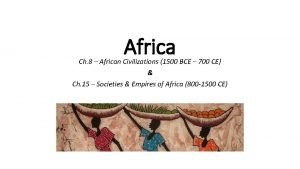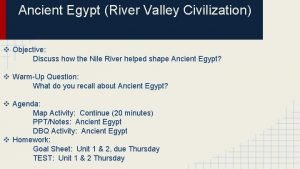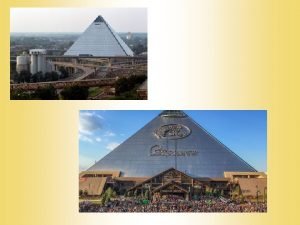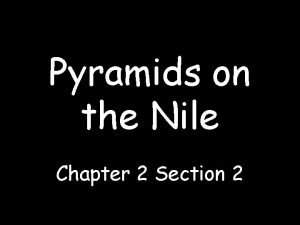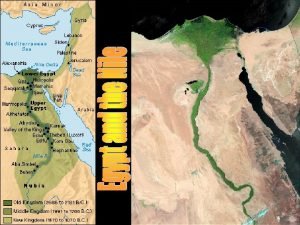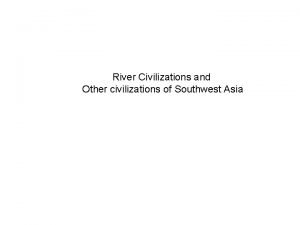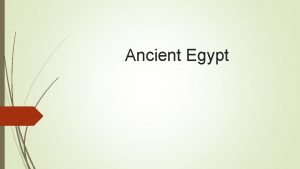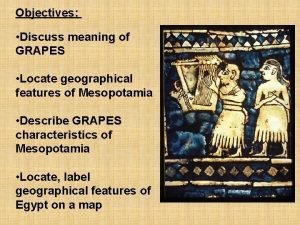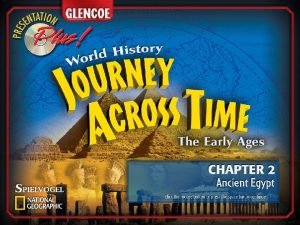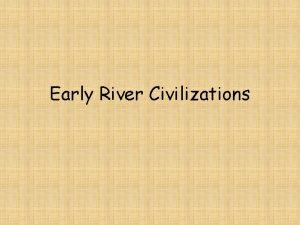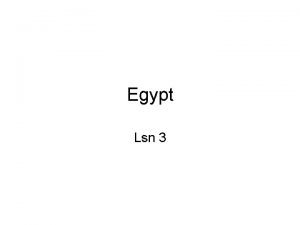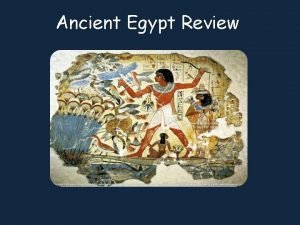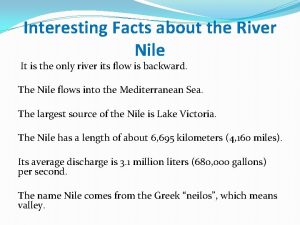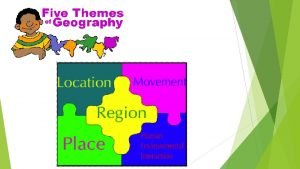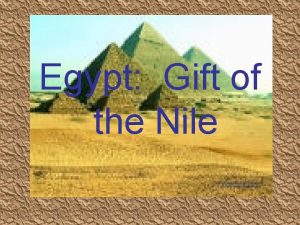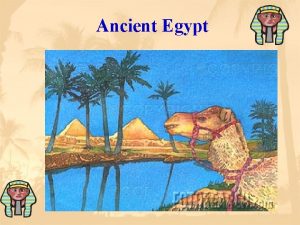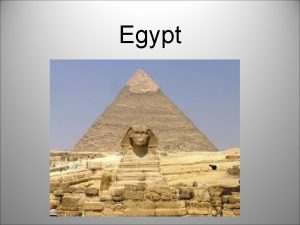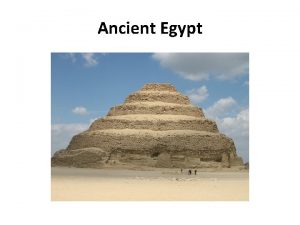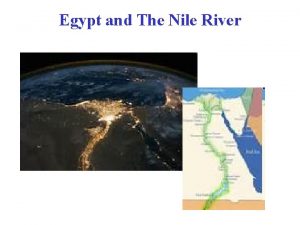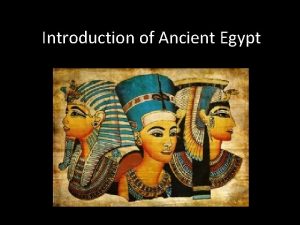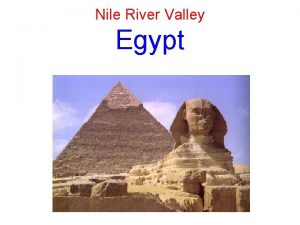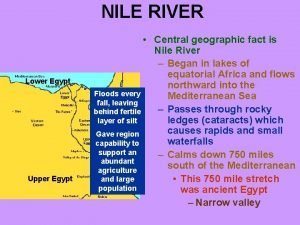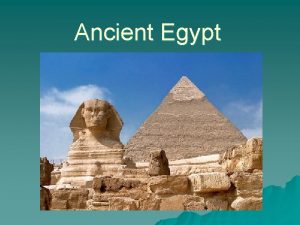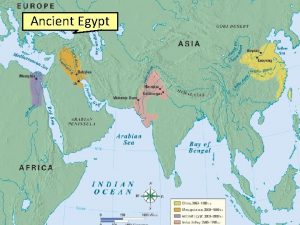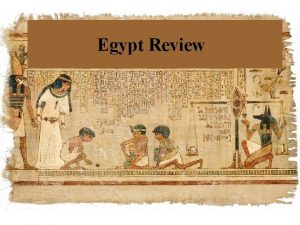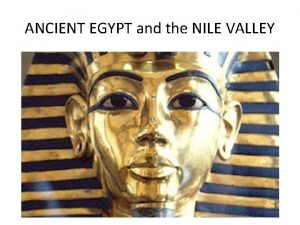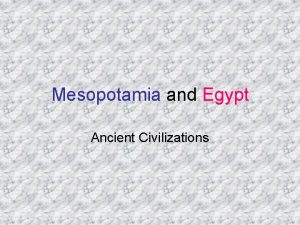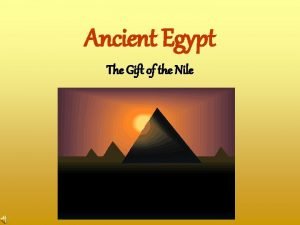Egypt The Gift of the Nile The Gift






























- Slides: 30

Egypt: The Gift of the Nile


“The Gift of the Nile” • The Nile is a long, powerful river running in a northerly direction some 750 miles from the last cataract to the Mediterranean. It floods- annually and predictably- an area five to 15 miles wide. About 5 % of Egypt is habitable. Without the Nile, there would be only barren desert. • From as early as 5000 BC, small communities along the Nile began to drain marshes, irrigate and plant regular crops • Slowly, these communities coalesced into nomes under nomarchs. Then the nomes of the South- “Upper Egypt” because it is nearer the source of the Nile - and the North – “Lower Egypt” nearer to the mouth of the Nile formed as larger entities


“The Gift of the Nile” – It seems that a need to control irrigation led to political organization on a larger scale – Much about this period is shrouded in legend, but about 2100 B. C. , Menes united Upper and Lower Egypt. This unification ushered in the historical period.

Course of Egyptian History • Historians divide Egypt's historical period into 30 -some dynasties, or families, of rulers. The dynasties are grouped into Old, Middle, and New Kingdoms, with intermediate periods between. • The Old Kingdom (2695 -2160 b. c. ) was an era of great vitality, security and prosperity – Egypt was isolated and untroubled by invaders – A distinctive Egyptian kingship evolved. The word Pharaoh comes from per aa, meaning the “Great House”. Pharaoh was on of the gods and guaranteed Egypt’s prosperity and security. In turn, the prosperity and security legitimized the Pharaoh. – The Great Pyramids of Gizeh symbolize the Old Kingdom

Course of Egyptian History • The Middle Kingdom (2025 -1786) was a period of more widely dispersed rule. – Pharaoh’s shared power with local notables – This period was important in the elaboration of Egyptian religion because the emphasis moved beyond the royal dynasty to nobles and even ordinary people. • Around 1700 BC the Hyksos, Semitic-speaking peoples from Palestine, conquered Egypt.


Course of Egyptian History • Hatred foreign rule eventually led a dynasty from Upper Egypt to drive out the Hyksos and inaugurate the New Kingdom (1550 -1075) – Fired by ambition and a desire to ward off future conquest, the Egyptians now built an empire that extended into Mesopotamia and along the shore of the Mediterranean. – That was a brilliant and cosmopolitan period. – After about 1400 BC, the Egyptians confronted the Hittites, a powerful and expanding people from Anatolia (modern Turkey) and the first Indo-European speakers in recorded history. In 1274, at Qadesh in northern Syria, the Egyptians fought a battle with the Hittites that left them both crippled and declining.

Culture of Ancient Egypt • Everything starts with the Pharaoh in a two-class society ( the Pharaoh and everyone else). Egypt first displayed an abstract sense of rule- the separation of ruler and office and the complete removal of the ruler from the ordinary realm of humans. • Religion grew more complicated over time – The peace and prosperity of the Old Kingdom led to a happy optimistic outlook – The concept of the afterlife- as a continuation of this life, something better- was reserved mainly to the Pharaoh, his family and maybe a few key advisors.


Culture of Ancient Egypt – The Middle Kingdom saw a profusion of temples and new cults. Herodotus called the Egyptian the “most religious of all people” This might have been a reemergence of predynastic religion or a response to unsettled conditions. At this time, the afterlife seems to have been considered available to all. – The concept of Ma’at became crucial, that is, the idea of truth, justice, balance and order. – The myth of Osiris revealing the Middle Kingdom was popular – The New Kingdom saw the remarkable religious experiment of Akhenaton. He abandoned traditional worship to promote the cult of Aton (henotheism or monotheism) but this died with him.


Scientific and artisanal advances • The use of papyrus facilitated writing and recordkeeping • Hieroglyphic (pictograph) writing gave way gradually to demotic, which was a more efficient cuneiform. • The desire to preserve bodies intact (mummification) for the afterlife led to advances in medical science, including surgery and knowledge of anatomy.


Legacy of Egypt • Greeks and Romans were impressed, even dazzled, by the Egyptians, as have been most visitors to Egypt since antiquity • Seeing just what influence Egypt had however is not so easy – Political control lasted a short time – Divinized kingship recurred but not necessarily because of the Egyptians – No new literary forms were added – Monumental architecture as propaganda recurred, but this idea is not “Egyptian”


Legacy of Egypt • Early Egyptologists were eager to claim the ancient Egyptians for the West – After WW II, as colonial empires crumbled and black consciousness arose, some people claimed that Egypt was an African civilization, indeed, that Egypt was Africa and vice versa – In its most extreme forms, this view has held that Western Civilization was stolen from the Egyptians by the Greeks – This view again puts a sharp focus on Egypt but without solid reasons for doing so

Hebrews: Small States and Big Ideas


After the Egyptians, Before the Romans • Sea peoples, most famously the Philistines, attacked along the Eastern shore of the Mediterranean after about 1200 B. C. • The Phoenicians managed to avoid conquest. They were Canaanites who spoke a Semitic language and who had been present in the region of what is today coastal Syria and Lebanon for centuries – After about 900, they created one of the first great commercial empires the world had seen, anticipating the Athenians, Venetians, and Dutch

After the Egyptians, Before the Romans – Creating colonies all over the Mediterranean, Carthage and Massilia, the Phoenicians played a role in spreading Mesopotamian culture and in beginning the creation of a Mediterranean cultural network – By 600 B. C. , they had almost certainly circumnavigated Africa and, by about 450, they had reached Britain. • The other significant people who emerged in this big -power pause were the Hebrews – Again, much of the Hebrews history is shrouded in legend. A pastoralist, Abraham, who has been dated between 2000 and 1550 B. C. , was the leader of a people who were on the outs with the settled city-dwellers and grain farmers of Sumer


After the Egyptians, Before the Romans – Abraham and his God made a pact, and Abraham was told to leave Ur for the land of Canaan/Palestine – For some centuries, Abraham’s descendants farmed land, quarreled among themselves, and tried to ward off enemies – Eventually, they were swept up in the struggles between the Egyptians and the Hittites. The familiar story says that the Hebrews were carried off into bondage to Egypt. Some probably prisoners of war, but other doubtless migrated their voluntarily because the area was more peaceful and prosperous. – Moses arose as a leader who forged a people during the Exodus, a long process of departing from Egypt and reentering the “promised land”

After the Egyptians, Before the Romans – Hebrews lived under numerous independent judges, but the threat of the sea peoples, chiefly the Philistines, induced them to choose Kings, first Saul, then David, then Solomon – Under Solomon, the Kingdom reached its high point, and considerable commercial wealth flowed in – But a distaste for strong central authority led to a division Israel in the north, with its capital Samaria, and Judah in the South, with its capital Jerusalem – Eventually, these small kingdoms were conquered by more powerful neighbors: Israel fell to the Assyrians in 722 and Judah, to the Neo-Babylonians in 586. The Assyrians in particular conducted the “Diaspora” or the dispersal of the Hebrews all over the near East.

Religion of the Hebrews • Our knowledge of the beliefs of the Hebrews comes from a collection of writings that in some ways cover the period from about 2000 B. C. to 200 B. C. , but that were mostly written down after 1000 B. C. – These writings are properly called the Hebrew Bible, or the Hebrew scriptures. (Pentateuch-Genesis, Exodus, Leviticus, Numbers, and Deuteronomy, etc …). – The Christians, these materials are the Old Testament

The Hebrew Bible consists of three major themes: – The Torah: sometimes called the “books of Moses”. The name means “the teaching” contains the prescriptions that governed Hebrew life. – The Prophets: contains both historical books, such as Kings, Samuel and Chronicles, reveals God’s relationship with Hebrews, and more obviously prophetic books of the “Greater Prophets” and the “Lesser Prophets” – The Writings: designation for the poetic material, such as Psalms and Canticles, and for the beautiful moving literature, such as Proverbs and Wisdom.

Central Religious ideas • The idea of the covenant; created between Yahweh and Abrahamand the Semitic tribe- renewed between Yahweh and Moses- God and the people- It was redefined by the prophet Ezra during the Exile- between God and a people adhering to the Torah – The unique notion of reciprocity appears here for the first time – The covenant also embodies the unique notion of a chosen people: One God for one people, not a god for a place or a state • The idea of exclusive monotheism. This idea has a long evolution, from henotheism, still present in the time of Moses, to monotheism in the time of Isaiah – This occasioned a profound tension between the idea that Yahweh was the only God and the God of the Hebrews, and the possibility of universalism – The idea is seen most vividly in the book of Jonah

Central Religious ideas • The idea of ethical monotheism. This profound sense of social justice that runs through the prophetic books is unprecedented in the previous religious experience of known peoples (10 Commandments 1 -3 relation between man and God-4 -7 relation between man and society). – God demanded a particular kind of behavior as a guarantee of his continuing benevolence – This idea is seen in the Decalogue and Shema, in Micah 1. A fundamental set of rules having authoritative weight— The Ten Commandments (Deca= 10).

Hebrew Legacy • Philosophers and theologians have long acknowledged the importance of monotheism for everything from natural philosophy to political ideology. • Numerous people in the West have called themselves “New Israel” as a way of claiming unique, chosen relationship with providence. • Historically, social justice has sometimes been a secular concern, but much more often, one with religious roots. • Western literature is unimaginable without its fundamental formative text: The Bible
 Egypt is the gift of the nile
Egypt is the gift of the nile Aksum had access to the red sea blue nile and white nile
Aksum had access to the red sea blue nile and white nile How did the nile shape ancient egypt essay
How did the nile shape ancient egypt essay How did the nile shape ancient egypt dbq answer key
How did the nile shape ancient egypt dbq answer key Upper egypt and lower egypt
Upper egypt and lower egypt Chapter 2 section 2 pyramids on the nile
Chapter 2 section 2 pyramids on the nile Wheres the nile river
Wheres the nile river Nile floodplain
Nile floodplain Frontalism definition
Frontalism definition A section of the nile river with rapids and rocky terrain
A section of the nile river with rapids and rocky terrain Nile river
Nile river Egypt advanced cities
Egypt advanced cities Six cataracts of the nile river
Six cataracts of the nile river Nile river clipart
Nile river clipart Nile river basin
Nile river basin What does the picture tell us?
What does the picture tell us? Background blue
Background blue Egypt relative location
Egypt relative location Kush nile river
Kush nile river Gary leon ridgway
Gary leon ridgway Why was napata's location advantageous
Why was napata's location advantageous Janapriya nile valley
Janapriya nile valley Hapi (nile god)
Hapi (nile god) Tigris euphrates and nile river
Tigris euphrates and nile river Nile river basin
Nile river basin What was this called
What was this called River nile is called the lifeline of
River nile is called the lifeline of Nile chemicals
Nile chemicals River nile fun facts
River nile fun facts Hemorosis
Hemorosis Absolute and relative direction
Absolute and relative direction

